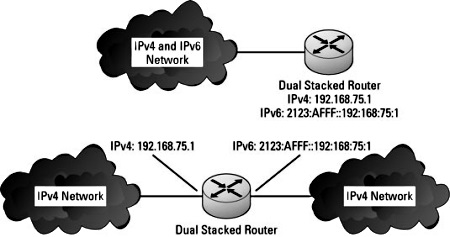Integration of IPv6 with IPv4
By Edward Tetz
Because the entire world is currently running IPv4, one of the big questions is how to move
people over to IPv6. It is not like they can just announce that on January 1 the Internet will
use only IPv6. That just would not work.
So instead, a way to slowly migrate people to the new addressing scheme while allowing them
to keep everything that they currently have in place has been developed. To that goal, there
are three basic methods of compatibility:
• Dual-stack: In dual-stack configuration, the device is configured for both IPv4
and IPv6 network stacks. The dual-stack configuration can be implemented on a single interface
or with multiple interfaces. In this configuration, the device decides how to send the traffic
based on the destination address of the other device.
As of IOS 12.2(2), Cisco is IPv6-ready. To support dual-stack routing on a single interface,
you need to configure IPv6 on your routing device. The following commands allow for forwarding
of IPv6 data packets:

Router1> enable
Router1# configure terminal
Router1(config)# ipv6 unicast-routing
Router1(config)# interface ethernet0
Router1(config-if)# ip address 192.168.75.1 255.255.255.0
Router1(config-if)# ipv6 address 2123:AFFF::192:168:75:1/120
Router1(config-if)# exit
Router1(config)# exit
Router1# copy running-config startup-config
• Tunneling: Tunneling refers to passing IPv6 data over an IPv4 network by placing
the IPv6 packet into the data section of an IPv4 packet, as shown in Figure 4-2. The four main
types of tunneling are:
• Manual IPv6-to-IPv4 tunneling encapsulates an IPv6 packet in an IPv4 packet.
So as to not fragment the packet from adding the IPv4 header to it, the data packet needs to be
reduced by 20 bytes if the IPv4 has an optional protocol field, or 20 octets if it does not, as
well as require routers support both IP stacks.
• Dynamic 6-to-4 tunneling routes data between islands of IPv6 routers across your network.
• Intra-Site Automatic Tunnel Addressing Protocol (ISATAP) tunneling uses
the existing IPv4 network as the link layer of the IPv6 network and routes the data between the
IP networks via routers supporting both IP stacks.
• Teredo tunneling performs the tunneling work at the dual-stacked host on
either end of the connection rather than at a gateway router.

• Proxying and translation (NAT-PT): Network Address Translation-Protocol Translation
(NAT-PT) places a translation mechanism on the network, which translates traffic going back and
forth between IPv4 and IPv6.
With these methods available to companies, ISPs, and users, the path to migrate your network to
IPv6 does not need to be long or difficult.
This is an excerpt from
Cisco Networking All-in-One For Dummies.

| 
